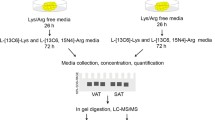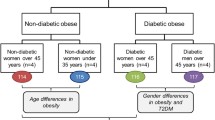Abstract
Obesity is presently reaching pandemic proportions and it is becoming a major health concern in developed and developing countries due to its comorbidities like type II diabetes, cardiovascular pathologies, and some cancers. The discovery of the adipose tissue role as an endocrine gland able to secrete adipokines that affects whole-body energy homeostasis has become a key break-through toward a better molecular understanding of obesity. Among the known adipokines involved in the regulation of energy metabolism very few have been clearly seen as central regulators of insulin sensitivity, metabolism, and energy homeostasis. Thus, the discovery and characterization of new adipocyte-derived factors is still in progress. Proteomics technology has emerged as a useful tool to analyze adipose tissue secretion (secretome) dynamics giving a wider picture into the molecular events that control body weight. Besides the identification of new secreted proteins, the advantage of using this approach is the possibility to detect post-translational modifications and protein interactions that generally cannot be predicted by genome studies. In this review, we summarize the recent efforts to identify new bioactive adipokines by proteomics especially in pathological situations such as obesity.



Similar content being viewed by others
References
L. Qi, Y.A. Cho, Gene-environment interaction and obesity. Nutr. Rev. 66, 684–694 (2008)
D.H. Bessesen, Update on obesity. J. Clin. Endocrinol. Metab. 93, 2027–2034 (2008)
D.M. Mutch, K. Clément, Unraveling the genetics of human obesity. PLoS Genet. 2, e188 (2006)
M. Seip, O. Trygstad, Generalized lipodystrophy, congenital and acquired (lipoatrophy). Acta Paediatr. Suppl. 413, 2–28 (1996)
J. Moitra, M.M. Mason, M. Olive, D. Krylov, O. Gavrilova, B. Marcus-Samuels, L. Feigenbaum, E. Lee, T. Aoyama, M. Eckhaus, M.L. Reitman, C. Vinson, Life without white fat: a transgenic mouse. Genes Dev. 12, 3168–3181 (1998)
B. Antuna-Puente, B. Feve, S. Fellahi, J.-P. Bastard, Adipokines: the missing link between insulin resistance and obesity. Diabetes Metab. 34, 2–11 (2008)
H. Hauner, Secretory factors from human adipose tissue and their functional role. The Proc. Nutr. Soc. 64, 163–169 (2005)
N. Halberg, I. Wernstedt-Asterholm, and P.E. Scherer, The adipocyte as an endocrine cell. Endocrinol. Metab. Clin. North. Am. 37, 753–68, x–xi (2008)
L. Hutley, J.B. Prins, Fat as an endocrine organ: relationship to the metabolic syndrome. Am. J. Med. Sci. 330, 280–289 (2005)
K. Brochu-Gaudreau, C. Rehfeldt, R. Blouin, V. Bordignon, B.D. Murphy, M.F. Palin, Adiponectin action from head to toe. Endocrine 37, 11–32 (2010)
M. Blüher, Vaspin in obesity and diabetes: pathophysiological and clinical significance. Endocrine (2011) (in press)
I. Castan-Laurell, C. Dray, C. Attané, T. Duparc, C. Knauf, P. Valet, Apelin, diabetes, and obesity. Endocrine 40, 1–9 (2011)
M. Tyers, M. Mann, From genomics to proteomics. Nature 422, 193–197 (2003)
M.P. Pavlou, E.P. Diamandis, The cancer cell secretome: a good source for discovering biomarkers? J. Proteomics. 73, 1896–1906 (2010)
M.P. et al. Lodish G, Berk A, Zipursky SL. Mol. Cell Biol. New York (1999)
H. Skalnikova, J. Motlik, S.J. Gadher, H. Kovarova, Mapping of the secretome of primary isolates of mammalian cells, stem cells and derived cell lines. Proteomics 11, 691–708 (2011)
C. van Vliet, E.C. Thomas, A. Merino-Trigo, R.D. Teasdale, P.A. Gleeson, Intracellular sorting and transport of proteins. Prog. Biophys. Mol. Biol. 83, 1–45 (2003)
W. Nickel, C. Rabouille, Mechanisms of regulated unconventional protein secretion. Natl. Rev. Mol. Cell. Biol. 10, 148–155 (2009)
N. Aoki, S. Jin-no, Y. Nakagawa, N. Asai, E. Arakawa, N. Tamura, T. Tamura, T. Matsuda, Identification and characterization of microvesicles secreted by 3T3-L1 adipocytes: redox- and hormone-dependent induction of milk fat globule-epidermal growth factor 8-associated microvesicles. Endocrinology 148, 3850–3862 (2007)
J.D. Bendtsen, L.J. Jensen, N. Blom, G. Von Heijne, S. Brunak, Protein Eng. Des. Sel. 17, 349–356 (2004)
J.D. Bendtsen, H. Nielsen, G. von Heijne, S. Brunak, Improved prediction of signal peptides: SignalP 3.0. J. Mol. Biol. 340, 783–795 (2004)
M. Bodén and J. Hawkins, Prediction of subcellular localization using sequence-biased recurrent networks. Bioinformatics (Oxford, England) 21, 2279–2286 (2005)
O. Emanuelsson, H. Nielsen, S. Brunak, G. von Heijne, Predicting subcellular localization of proteins based on their N-terminal amino acid sequence. J. Mol. Biol. 300, 1005–1016 (2000)
S.-H. Chiou, C.-Y. Wu, Clinical proteomics: current status, challenges, and future perspectives. Kaohsiung J. Med. Sci. 27, 1–14 (2011)
G. Alvarez-Llamas, E. Szalowska, M.P. de Vries, D. Weening, K. Landman, A. Hoek, B.H.R. Wolffenbuttel, H. Roelofsen, R.J. Vonk, Characterization of the human visceral adipose tissue secretome. Mol. Cell Proteomics 6, 589–600 (2007)
X. Chen, S. Hess, Adipose proteome analysis: focus on mediators of insulin resistance. Expert Rev. Proteomics 5, 827–839 (2008)
J.C. Sanchez, D. Chiappe, V. Converset, C. Hoogland, P.A. Binz, S. Paesano, R.D. Appel, S. Wang, M. Sennitt, A. Nolan, M.A. Cawthorne, D.F. Hochstrasser, The mouse SWISS-2D PAGE database: a tool for proteomics study of diabetes and obesity. Proteomics 1, 136–163 (2001)
S. Yang, C.-M., Huang, Recent advances in protein profiling of tissues and tissue fluids. Expert Rev. Proteomics. 4, 515–529 (2007)
M. Pardo, R.A. Dwek, N. Zitzmann, Proteomics in uveal melanoma research: opportunities and challenges in biomarker discovery. Expert Rev. Proteomics 4, 273–286 (2007)
P. Wang, E. Mariman, J. Keijer, F. Bouwman, J.-P. Noben, J. Robben, J. Renes, Profiling of the secreted proteins during 3T3-L1 adipocyte differentiation leads to the identification of novel adipokines. Cell. Mol. Life Sci. 61, 2405–2417 (2004)
I.A. Brewis, P. Brennan, Proteomics technologies for the global identification and quantification of proteins. Adv. Protein Chem. Struct. Biol. 80, 1–44 (2010)
H. Roelofsen, M. Dijkstra, D. Weening, M.P. de Vries, A. Hoek, R.J. Vonk, Comparison of isotope-labeled amino acid incorporation rates (CILAIR) provides a quantitative method to study tissue secretomes. Mol. Cell Proteomics 8, 316–324 (2009)
X. Chen, D. Hunt, S.W. Cushman, S. Hess, Proteomic characterization of thiazolidinedione regulation of obese adipose secretome in Zucker obese rats. Proteomics Clin. Appl. 3, 1099–1111 (2009)
X. Chen, S.W. Cushman, L.K. Pannell, S. Hess, Quantitative proteomic analysis of the secretory proteins from rat adipose cells using a 2D liquid chromatography-MS/MS approach. J. Proteome Res. 4, 570–577 (2005)
S. Famulla, D. Lamers, S. Hartwig, W. Passlack, A. Horrighs, A. Cramer, S. Lehr, H. Sell, J. Eckel, Pigment epithelium-derived factor (PEDF) is one of the most abundant proteins secreted by human adipocytes and induces insulin resistance and inflammatory signaling in muscle and fat cells. Int. J. Obes. 35, 762–772 (2011)
D. Lamers, S. Famulla, N. Wronkowitz, S. Hartwig, S. Lehr, D.M. Ouwens, K. Eckardt, J.M. Kaufman, M. Ryden, S. Müller, F.-G. Hanisch, J. Ruige, P. Arner, H. Sell, J. Eckel, Dipeptidyl peptidase 4 is a novel adipokine potentially linking obesity to the metabolic syndrome. Diabetes 60, 1917–1925 (2011)
S. Zvonic, M. Lefevre, G. Kilroy, Z.E. Floyd, J.P. DeLany, I. Kheterpal, A. Gravois, R. Dow, A. White, X. Wu, J.M. Gimble, Secretome of primary cultures of human adipose-derived stem cells: modulation of serpins by adipogenesis. Mol. Cell Proteomics 6, 18–28 (2007)
M.J. Lee, J. Kim, M.Y. Kim, Y.-S. Bae, S.H. Ryu, T.G. Lee, J.H. Kim, Proteomic analysis of tumor necrosis factor-alpha-induced secretome of human adipose tissue-derived mesenchymal stem cells. J. Proteome Res. 9, 1754–1762 (2010)
D.M. Mutch, C. Rouault, M. Keophiphath, D. Lacasa, K. Clément, Using gene expression to predict the secretome of differentiating human preadipocytes. Int. J. Obes. 33, 354–363 (2009)
C. Chiellini, O. Cochet, L. Negroni, M. Samson, M. Poggi, G. Ailhaud, M.-C. Alessi, C. Dani, E.-Z. Amri, Characterization of human mesenchymal stem cell secretome at early steps of adipocyte and osteoblast differentiation. BMC Mol. Biol. 9, 26 (2008)
H. Molina, Y. Yang, T. Ruch, J.-W. Kim, P. Mortensen, T. Otto, A. Nalli, Q.-Q. Tang, M.D. Lane, R. Chaerkady, A. Pandey, Temporal profiling of the adipocyte proteome during differentiation using a five-plex SILAC based strategy. J. Proteome Res. 8, 48–58 (2009)
J. Zhong, S.A. Krawczyk, R. Chaerkady, H. Huang, R. Goel, J.S. Bader, G.W. Wong, B.E. Corkey, A. Pandey, Temporal profiling of the secretome during adipogenesis in humans. J. Proteome Res. 9, 5228–5238 (2010)
J. Kim, Y.S. Choi, S. Lim, K. Yea, J.H. Yoon, D.-J. Jun, S.H. Ha, J.-W. Kim, J.H. Kim, P.-G. Suh, S.H. Ryu, T.G. Lee, Comparative analysis of the secretory proteome of human adipose stromal vascular fraction cells during adipogenesis. Proteomics 10, 394–405 (2010)
N. Billon, M.C. Monteiro, C. Dani, Developmental origin of adipocytes: new insights into a pending question. Biol. Cell 100, 563–575 (2008)
M. Toyoda, Y. Matsubara, K. Lin, K. Sugimachi, M. Furue, Characterization and comparison of adipose tissue-derived cells from human subcutaneous and omental adipose tissues. Cell Biochem. Funct. 27, 440–447 (2009)
A.W.B. Joe, L. Yi, Y. Even, A.W. Vogl, F.M.V. Rossi, Depot-specific differences in adipogenic progenitor abundance and proliferative response to high-fat diet. Stem cells. 27, 2563–2570 (2009)
S. Santosa, M.D. Jensen, Why are we shaped differently, and why does it matter? Am. J. Physiol. Endocrinol. Metab 295, E531–E535 (2008)
M.M. Ibrahim, Subcutaneous and visceral adipose tissue: structural and functional differences. Obes. Rev. 11, 11–18 (2010)
P. Arner, Regional adipocity in man. J. Endocrinol. 155, 191–192 (1997)
J.R. Peinado, Y. Jimenez-Gomez, M.R. Pulido, M. Ortega-Bellido, C. Diaz-Lopez, F.J. Padillo, J. Lopez-Miranda, R. Vazquez-Martínez, M.M. Malagón, The stromal-vascular fraction of adipose tissue contributes to major differences between subcutaneous and visceral fat depots. Proteomics 10, 3356–3366 (2010)
R. Pérez-Pérez, F.J. Ortega-Delgado, E. García-Santos, J.A. López, E. Camafeita, W. Ricart, J.-M. Fernández-Real, B. Peral, Differential proteomics of omental and subcutaneous adipose tissue reflects their unalike biochemical and metabolic properties. J. Proteome Res. 8, 1682–1693 (2009)
S.L. Hocking, L.E. Wu, M. Guilhaus, D.J. Chisholm, D.E. James, Intrinsic depot-specific differences in the secretome of adipose tissue, preadipocytes, and adipose tissue-derived microvascular endothelial cells. Diabetes. 59, 3008–3016 (2010)
R. Ross, L. Léger, D. Morris, J. de Guise, R. Guardo, Quantification of adipose tissue by MRI: relationship with anthropometric variables. J. Appl. Physiol. 72, 787–795 (1992)
A. Roca-Rivada, J. Alonso, O. Al-Massadi, C. Castelao, J.R. Peinado, L.M. Seoane, F.F. Casanueva, M. Pardo, Secretome analysis of rat adipose tissues shows location-specific roles for each depot type. J. Proteomics 74, 1068–1079 (2011)
Acknowledgments
This study has been funded by Instituto de Salud Carlos III (ISCIII: Ministerio de Ciencia e Innovación de España): FIS PI0/00537 (FEDER co-financing); FIS PS09/02075; CP08/00216; Xunta de Galicia 10PXIB918273PR. A.R–R is funded by CIBER FisiopatologíaObesidad y Nutrición (CB06/03); M.P. is a Miguel Servet Fellow (Instituto de Salud Carlos III/SERGAS).L.M.Seoane is a ISCIII/SERGAS Researcher.
Author information
Authors and Affiliations
Corresponding authors
Rights and permissions
About this article
Cite this article
Pardo, M., Roca-Rivada, A., Seoane, L.M. et al. Obesidomics: contribution of adipose tissue secretome analysis to obesity research. Endocrine 41, 374–383 (2012). https://doi.org/10.1007/s12020-012-9617-z
Received:
Accepted:
Published:
Issue Date:
DOI: https://doi.org/10.1007/s12020-012-9617-z




